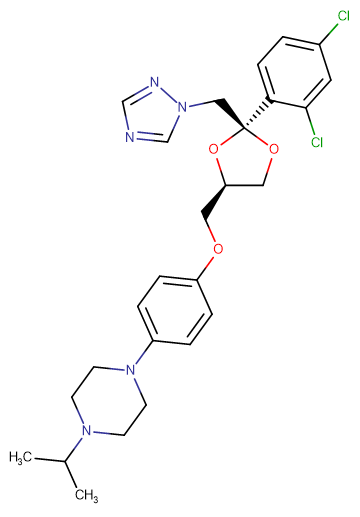
Terconazole
CAS No. 67915-31-5
Terconazole( NSC 331942 | R-42470 | (±)-Terconazole )
Catalog No. M15592 CAS No. 67915-31-5
Arecoline is a muscarinic acetylcholine receptor agonist.
Purity : >98% (HPLC)
 COA
COA
 Datasheet
Datasheet
 HNMR
HNMR
 HPLC
HPLC
 MSDS
MSDS
 Handing Instructions
Handing Instructions
| Size | Price / USD | Stock | Quantity |
| 50MG | 39 | In Stock |


|
| 100MG | 58 | In Stock |


|
| 200MG | Get Quote | In Stock |


|
| 500MG | Get Quote | In Stock |


|
| 1G | Get Quote | In Stock |


|
Biological Information
-
Product NameTerconazole
-
NoteResearch use only, not for human use.
-
Brief DescriptionArecoline is a muscarinic acetylcholine receptor agonist.
-
DescriptionArecoline is a muscarinic acetylcholine receptor agonist. Arecoline induces ADP ribosylation of histones and chromatid relaxation in spleen and bone marrow cells.(In Vitro):Terconazole inhibits the growth of Candida albicans ATCC 44859 in a concentration-related manner, but with modest effects noted at levels from 0.1 to 10 μM when the yeast is grown on media favoring the cell form. The inhibitory potency of terconazole on yeast cell viability varies with the strain and species of Candida tested. The susceptibility of C. albicans ATCC 44859 to terconazole is markedly enhanced when the yeast is grown on Eagle minimum essential medium, which favors mycelium formation. There is a progression of changes, from loss of mycelia formation at 0.1 μM terconazole through complete necrosis at 100 μM. Terconazole blocks the morphogenetic transformation from the yeast into the filamentous form at concentrations of 0.008 to 0.05 microgram/mL.(In Vivo):A 3-day once-daily intravaginal application of terconazole 0.8% is usually sufficient to provide a functional therapeutic period of 7 days because of prolonged high biologically active antifungal levels in the vagina. No side effects are observed at any concentration of terconazole.
-
In VitroTerconazole inhibits the growth of Candida albicans ATCC 44859 in a concentration-related manner, but with modest effects noted at levels from 0.1 to 10 μM when the yeast is grown on media favoring the cell form. The inhibitory potency of terconazole on yeast cell viability varies with the strain and species of Candida tested. The susceptibility of C. albicans ATCC 44859 to terconazole is markedly enhanced when the yeast is grown on Eagle minimum essential medium, which favors mycelium formation. There is a progression of changes, from loss of mycelia formation at 0.1 μM terconazole through complete necrosis at 100 μM. Terconazole blocks the morphogenetic transformation from the yeast into the filamentous form at concentrations of 0.008 to 0.05 microgram/mL.
-
In VivoA 3-day once-daily intravaginal application of terconazole 0.8% is usually sufficient to provide a functional therapeutic period of 7 days because of prolonged high biologically active antifungal levels in the vagina. No side effects are observed at any concentration of terconazole.
-
SynonymsNSC 331942 | R-42470 | (±)-Terconazole
-
PathwayMicrobiology/Virology
-
TargetAntifection
-
Recptor14-α Demethylase
-
Research AreaInfection
-
Indication——
Chemical Information
-
CAS Number67915-31-5
-
Formula Weight532.46
-
Molecular FormulaC26H31Cl2N5O3
-
Purity>98% (HPLC)
-
SolubilitySoluble in DMSO
-
SMILESCC(N1CCN(C2=CC=C(OC[C@H]3O[C@](CN4N=CN=C4)(C5=CC=C(Cl)C=C5Cl)OC3)C=C2)CC1)C
-
Chemical Name1-(4-(((2S,4R)-2-((1H-1,2,4-triazol-1-yl)methyl)-2-(2,4-dichlorophenyl)-1,3-dioxolan-4-yl)methoxy)phenyl)-4-isopropylpiperazine
Shipping & Storage Information
-
Storage(-20℃)
-
ShippingWith Ice Pack
-
Stability≥ 2 years
Reference
1.Zhao XY, et al. Chin Med J (Engl). 2012 Mar;125(6):1068-75.
molnova catalog



related products
-
Sorbic acid
Sorbic acid is a natural product that inhibits various bacteria including sporeformers.
-
Bacopasaponin C
Bacopasaponin C may have antioxidant activity, it also shows anti-leishmanial property.
-
13,21-Dihydroeurycom...
13,21-Dihydroeurycomanone is a natural product isolated from the root of Eurycoma longifolia with antiparasitic activity such as Plasmodium falciparum and Toxoplasma gondii.



 Cart
Cart
 sales@molnova.com
sales@molnova.com


